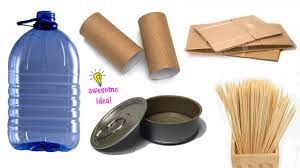Courtesy : constrofacilitator.com
Reuse of materials
Environmental Management and Strategies for Building Material Reuse and Recycle in Buildings
Leaders of successful, high-growth companies understand that innovation is what drives growth, and innovation is achieved by awesome people with a shared relentless growth attitude and shared passion for problem solving and for turning ideas into realities. Companies that continuously innovate will create and re-invent new markets, products, services, and business models – which lead to more growth. Innovation is founded on your enterprise’s ability to recognize market opportunities, your internal capabilities to respond innovatively, and your knowledge base. So, the best thing to do to guarantee growth is to build a sustainable innovation organization around the following components:
- Vision and strategy for innovation
- Culture supporting innovation
- Processes, practices and systems supporting innovation
- Top management team leading innovation
- Cross-functional teams mapping innovation road
- Empowered employees driving innovation.
Reuse and recycling of building material is a growing area of interest and concern in many parts of the country. Current practices and trends in the building material waste management area are examined from a building life cycle standpoint or cradle to reincarnation concept.
Strategies include zero waste, integrated recycling, international approaches, and reuse of materials, resource optimisation, waste reduction, and deconstruction. Examination of the waste management hierarchy and life cycle management of material is used to improve the understanding of reuse and recycle opportunities. Other considerations include cost, economic factors, social factors and environmental factors. All of these assessments are needed to develop a comprehensive waste management plan for a specific project.
It is important to recognize that the sustained growth in reuse efforts, as well as the sustained interest of the reuse industry, derives in large measure from the solid waste reduction hierarchy: Reduce, Reuse, and then recycle. It is best to reduce first, reuse as a second option, then to resort to recycling. Reuse is recognized as being distinct from recycling, both in doctrine, and in the handling of the materials this unique industry diverts from the waste stream. Recyclers have successfully kept materials out of the landfill by collecting, segregating, processing and manufacturing their collected goods into new products.

Why does reuse and recycling of building materials matter?
If you think about the sheer volume of material used throughout the building process, recycling building components makes logical sense. Reusing materials:
- Reduces the demand for new resources
- Cuts costs related to the production and transportation of new materials and
- Eliminates the need to send waste to landfill sites
Benefits of Reuse and Recycle
A. Environmental Benefits
Many reuse programs have evolved from local solid waste reduction goals because reuse requires fewer resources, less energy, and less labour, compared to recycling, disposal, or the manufacture of new products from virgin materials. Reuse provides an excellent, environmentally-preferred alternative to other waste management methods, because it reduces air, water and land pollution, limits the need for new natural resources, such as timber, petroleum, fibres and other materials.
B. Community Benefits
For many years, reuse has been used as a critical way of getting needed materials to the many disadvantaged populations that exist. Reuse continues to provide an excellent way in which to get people the food, clothing, building materials, business equipment, medical supplies and other items that they desperately need. There are other ways, however, that reuse benefits the community. Many reuse centres are engaged in job-training programs, programs for the handicapped or at-risk youth programs.
C. Economic Benefits
When reusing materials, instead of creating new products from virgin materials, there are fewer burdens on the economy. Reuse is an economical way for people of all socio-economic circles to acquire the items they need.
Different Approaches for Reuse and Recycle of Building Materials
Green Building
Sustainable design and construction, or “green building,” is a holistic approach that minimizes environmental impact, reduces maintenance, and creates a more desirable workspace for the building occupants. Green building focuses on siting issues, energy and water efficiency, recycled content building materials, minimizing local and global environmental effects caused by buildings, and indoor environmental quality. The goal is to transform the market of public funded construction, so that all projects will be designed and constructed reflecting green building principles. The requirements include;
- General framework for a methodology of calculation of the integrated performance of buildings.
- Setting of minimum energy standards in new and existing buildings.
- Energy certification of buildings
- Inspection and assessment of heating and cooling installations.
Buildings will have an impact on long-term energy consumption and new buildings should therefore meet minimum energy performance requirements tailored to the local climate. Best practice should in this respect be geared to the optimum use of factors relevant to enhancing energy performance. As the application of alternative energy supply systems is generally not explored to its full potential, the technical, environmental and economic feasibility of alternative energy supply systems should be considered; this can be carried out once, by the Member State, through a study which produces a list of energy conservation measures, for average local market conditions, meeting cost-effectiveness criteria. Before construction starts, specific studies may be requested if the measure, or measures, is deemed feasible. Incorporating reusable/recyclable/biodegradable building materials in your project can reduce waste, pollution, and energy use. Some examples of reusable / recyclable/ biodegradable building materials include:
- Wood (reusable/recyclable/biodegradable)
- Earthen Materials (reusable/biodegradable)
- Steel, Aluminium, Iron, Copper (reusable/recyclable)
- Bricks (reusable/recyclable)
- Concrete (may be crushed and recycled)
- Gypsum/Drywall (recyclable, sometimes biodegradable)
- Straw Bale Insulation (biodegradable)
- Wool Carpet (biodegradable)
- Linoleum Flooring (biodegradable)
Building materials composed of one substance (e.g., steel, concrete, wood, etc.), or that are readily disassembled into individual materials, are generally easiest to reuse or recycle. Materials composed of many ingredients, such as vinyl siding or wood chipboard are generally not readily reusable, recyclable, or biodegradable. Evaluate materials carefully. Are they the best choice for the application? Are they durable? Can they be readily disassembled for reuse, recycling, or degrading at the end of the useful life of the building?
The extraction, manufacture and transport, and disposal of virgin building materials pollute air and water, depletes resources, and damages natural habitats. Construction and demolition are responsible for roughly 30% of the solid waste stream and real-world case studies by Waste Management Authorities across the globe have demonstrated more t




